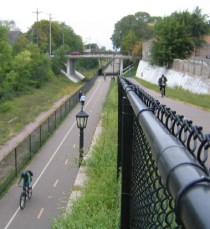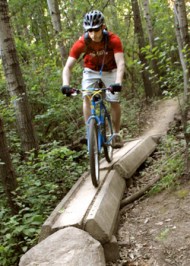“The real strength of Minneapolis is its absolutely gorgeous, truly world-class off-street path system. Each has separate space for pedestrians. I biked on a half dozen wide, gorgeous separated bike-ped bridges.”
— Mia Birk, CEO of Portland-based Alta Planning
In the wake of Portland losing the #1 ranking in Bicycling Magazine that we’ve owned since 1995, I’ve been thinking about what Minneapolis has that we don’t have.
I’ve come up with a few things.
Lots of Off-Street Trails
This is probably the best thing going for Minneapolis’ bikeway system. They’ve got 84 miles of off-street trails (like our Esplanade and Springwater Corridor) that connect through their metro area. Take the Midtown Greenway for instance, a 5.5 mile former rail corridor that can get you all the way across town.
Portland bike planning expert and author Mia Birk , who’s been all over the world designing bikeways for her company Alta Planning + Design, agrees. She told me the other day:
“The real strength of Minneapolis is its absolutely gorgeous, truly world-class off-street path system. Each has separate space for pedestrians. I biked on a half dozen wide, gorgeous separated bike-ped bridges.”
To rival Minneapolis’ off-street paths, Portland needs to get real about the Sullivan’s Gulch and North Portland Greenway trails.

(this is what my dreams of
Sullivan’s Gulch look like.)
(Photo: City of Minneapolis)
The Non-motorized Transportation Pilot Program
Minneapolis is one of five lucky cities that scored this a $25 million earmark in the federal transportation bill that passed in 2005 (and that was recently extended by the Obama Administration) specifically to fund biking and walking infrastructure.
Birk says, “The federal infusion has clearly been a catalyst for a major improvement.”
Transit for Livable Communities
This non-profit organization is the administrator of the federal money mentioned above. Through Bike Walk Twin Cities, Transit for Livable Communities oversees funding of bike projects and programs. Founded about the same time (1996) and with about the same number of staff (13) as Portland’s Bicycle Transportation Alliance, TLC advocates for biking, walking, transit, and “thoughtful development.” Unlike the BTA, the work of TLC is not constrained by a bike-only focus.
Public Bike Share (coming soon)
In June, with a $1.5 million grant from Uncle Sam (see above), the City of Minneapolis will launch the most ambitious public bike sharing program in the United States. Their NiceRide bike share program will have 1000 bikes available at 75 kiosks throughout downtown Minneapolis.
The City of Portland has put a considerable amount of effort and resources into their bike share plans, including a public demonstration from leading bike share vendors last summer. But as of now, they’ve put the plans on the shelf. Steve Hoyt-McBeth is the PBOT staffer handling the project. He says, “We’re still interested in bike sharing, but I think it’s fair to say we’re moving forward cautiously.”

(Photo: City of Minneapolis)
Single Track Mountain Bike Trails
As pointed out by a commenter and Minneapolis resident Julie Kosbab, there are several mountain bike trail corridors in the Minneapolis area. The most prominent, she says, is the Wirth Off-Road Trail (in photo at right). The 4.36 mile trail is near Minneapolis’ urban core and Kosbab says it’s easily accessible by area bikeways.
Portland on the other hand is still struggling to find the political will to improve single track opportunities in our nearby urban parks — especially Forest Park. A report on recent talks about that issue is forthcoming (but you can get a preview by reading the comments on the Land Rover story published yesterday).
Obviously, there’s more to a great biking city than the factors listed above. And, taken all together, I think most reasonable people would agree that — although we’ve lost our swagger of late — Portland is still the best city for biking in America. However, with cities like Minneapolis and New York City rising fast, we must do even more to maintain that title.

